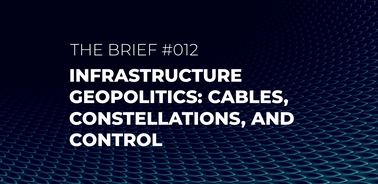- Home
- News And Events
- News
- The Brief #012 Infrastructure Geopolitics: Cables, Constellations And Control
THE BRIEF #012 Infrastructure Geopolitics: Cables, Constellations and Control

IN BRIEF
As geopolitical competition increasingly plays out through control of critical infrastructure—such as submarine cables and satellite systems—the global digital landscape is being reshaped by rival networks. In this context, Europe faces mounting pressure to invest in secure, sovereign infrastructure or risk strategic dependence on external actors
THE GIST
Meta recently announced Project Waterworth, a 50,000 km undersea data cable initiative connecting the U.S. with India, South Africa, Brazil, and other countries. Once completed, it will be the longest submarine cable system ever built, reflecting a broader trend: digital infrastructure is becoming a central element in global economic and geopolitical strategy.
Today, more than 95% of international data traffic flows through roughly 550 submarine cables. Traditionally developed by telecommunications consortia, many of these systems are now being funded and operated by large technology companies. This shift has drawn growing attention from policymakers, who see it as part of a wider concentration—not only over digital platforms and services but increasingly over the infrastructure that supports them.
Project Waterworth is expected to offer the U.S. government both geoeconomic and informational advantages, reinforcing a shift in how submarine cables are perceived—not merely as infrastructure, but as strategic assets. The U.S. has actively blocked Chinese participation in some recent cable projects. In parallel, tech-led projects like those of Google and Meta have been rerouted to avoid sensitive geographical areas. Meanwhile, China’s Digital Silk Road includes significant investments in alternative cable routes across Africa, Asia, and Europe, often in partnership with countries not involved in Western initiatives.
Beyond the sea, satellite internet systems are also transforming the global connectivity landscape. Providers like Starlink, OneWeb, and China’s GuoWang are deploying large-scale low-Earth orbit constellations to expand broadband access. Starlink’s role in Ukraine has highlighted how such systems can serve both civilian and national security purposes, underscoring their dual-use nature and prompting questions about governance, access, and the role of commercial actors in critical infrastructure.
THE TAKEAWAY
Taken together, these developments point to a new reality: the world’s digital landscape is increasingly being shaped by rival networks of physical infrastructure. As countries and companies invest in their own systems, geopolitical tensions are shaping not just digital regulation, but the very infrastructure of global connectivity.
Submarine cable landing points, satellite coverage zones, and the sovereignty of data routes are emerging as key elements in the global balance of power. Infrastructure is no longer a neutral backbone—it increasingly determines who is connected, how securely, and under whose terms. What happens when commercial actors wield critical geostrategic infrastructure?
Europe, in particular, faces a strategic dilemma. While it leads in digital regulation and values-based governance, it still depends heavily on infrastructure developed and owned elsewhere. Recent moves, such as the French government’s €1.35 billion capital injection into Eutelsat, signal a desire to strengthen Europe’s position as a sovereign counterweight to systems like Starlink. Yet unless Europe accelerates investment in secure and globally trusted infrastructure, it risks becoming a dependent consumer within a landscape of fragmented, competing digital systems.
DELVE DEEPER
- Beyond Lego: The Need for EU-Based Building Blocks of Technology (IE CGC, 2025), by Ferreira-Gomes, Okano-Heijmans and van den Wijngaard. The third paper of our project on the Geopolitics of the Digital Era analyzes the key building blocks that constitute the so-called technology stack, situating the EU in the global technology playing field and considering vital steps to boost the bloc’s digital competitiveness and economic security.
- The Geopolitics of Subsea Data Cables (Carnegie Endowment for International Peace, 2025) This project provides a cross-regional perspective on how geopolitical developments are impacting subsea cable investment, deployment, repair, and resilience in three geographical areas: Africa, Europe, and Southeast Asia.